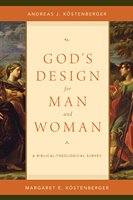About the Authors
Andreas J. Köstenberger (PhD, Trinity Evangelical Divinity School) is senior research professor of New Testament and biblical theology at Southeastern Baptist Theological Seminary in Wake Forest, NC. He is the author or editor of numerous books, including God, Marriage, and Family: Rebuilding the Biblical Foundation (with David W. Jones; Crossway, 2010) and Invitation to Biblical Interpretation: Exploring the Hermeneutical Triad of History, Literature, and Theology (with Richard D. Patterson; Kregel, 2011).
Margaret E. Köstenberger (ThD, University of South Africa) is an adjunct professor of women’s studies at Southeastern Baptist Theological Seminary and the author of Jesus and the Feminists: Who Do They Say That He is? (Crossway, 2008).
Introduction
In God’s Design for Man and Woman, Andreas and Margaret Köstenberger set forth a biblical theology of manhood and womanhood based on a survey of the relevant scriptural texts. Beginning in Genesis and working through Revelation, the Köstenbergers demonstrate that God established a clear pattern of male leadership throughout redemptive history that ought to guide homes and churches today.
Table of Contents
Introduction
1. God’s Original Design and Its Corruption (Genesis 1–3)
2. Patriarchs, Kings, Priests, and Prophets (Old Testament)
3. What Did Jesus Do? (Gospels)
4. What Did the Early Church Do? (Acts)
5. Paul’s Message to the Churches (First Ten Letters)
6. Paul’s Legacy (Letters to Timothy and Titus)
7. The Rest of the Story (Other New Testament Teaching)
8. God’s Design Lived Out Today
Appendix 1: The Three Waves: Women’s History Survey
Appendix 2: The Rules of the Game: Hermeneutics and Biblical Theology
Appendix 3: Proceed with Caution: Special Issues in Interpreting Gender Passages
Summary
Chapter 1
God’s Original Design and Its Corruption (Genesis 1–3)
In the creation account of Genesis 1–2, we learn that God created the man first to serve as a leader and then created the woman to be his helper and companion. Both were made in the image of God and are charged with carrying out his functional rule over the earth. As God’s representatives, Adam and Eve were commanded to exercise dominion over the rest of creation, primarily through uniting with one another in procreation. In an act of divine grace, God created Eve to be Adam’s partner in ruling the earth. The two were designed to complement one another in harmonious unity. Eve’s role as helper meant that she was placed under her husband’s care and authority, yet charged with fulfilling a significant role as his companion. The term “helper” is used in reference to God throughout the Psalms and should not be taken as a mark of inferiority. Rather, Eve was designed to complement Adam and unite with him as “one flesh” in the covenant of marriage (Gen 2:24).
This idyllic scene is radically altered by the fall of humanity recounted in Genesis 3. When the Serpent (Satan) entered the Garden, he sought out Eve, who then led her husband into sin, reversing the roles set in place by God. Satan deceived Eve by casting doubt on God’s generosity, integrity, and motives. While Eve fell into the Serpent’s trap, the narrative suggests that Adam did nothing to stop her, thus failing in his role as protector and leader.
God held Adam and Eve individually culpable for their actions, yet called the man to account first, indicating Adam’s ultimate responsibility for their disobedience. God’s judgment on the couple put a curse on their union. Instead of loving harmony, their relationship would now be marked by strenuous pain and struggles for power (Gen 3:16–19). Nonetheless, God mercifully clothed the couple as he expelled them from the Garden, demonstrating his steadfast love for them and foreshadowing the fulfillment of his promise that the offspring of the woman would one day crush the Serpent’s head (Gen 3:15).
Throughout the rest of the Old Testament narrative, God’s original design for man and woman was subverted by sinful practices such as polygamy, adultery, divorce, and homosexuality. Notwithstanding, there are notable instances of Old Testament writers celebrating the beauty of God’s plan for marriage (Proverbs 31, Song of Solomon).
Chapter 2
Patriarchs, Kings, Priests, and Prophets (Old Testament)
As was common at the time, Israelite families were patrilineal (descent traced through the father’s line), patrilocal (married women joined their husband’s household), and patriarchal (the father ruled the home). Given negative connotations with the word “patriarchy,” it is better to describe the Israelite home as “patricentric.” Patricentrism rightly conceives the father as…
[To continue reading this summary, please see below....]The remainder of this article is premium content. Become a member to continue reading.
Already have an account? Sign In
